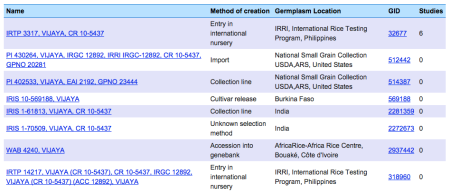Mike Jackson, who ran the IRRI genebank 20 years ago, has some provocative things to say on his blog about the International Network for Genetic Evaluation of Rice (INGER), which has just turned 40. Here is Mike’s main point:
In my opinion, INGER could—and should—have been more. According to the riceTODAY article, INGER is today, 40 years after it was founded, at ‘the crossroads’. But it was already at a crossroads almost 25 years ago when it became clear that UNDP support would end. Opportunities were not seized then, I contend, to bring about radical and efficient changes to the management and operations of this important rice germplasm network, but without losing any of the benefits of the previous 20 years. I also believed it should be possible to add even more scientific value.
If I understand Mike correctly, he thinks INGER has gone for quantity (of trials) rather than quality of late, and missed out on some clear opportunities to be even more successful than it has been. Counterfactual history is always tricky, but I wonder whether this is a testable proposition. Maybe there’s a natural experiment out there? For example, are there countries that have not taken much advantage of INGER in the past couple of decades. How have their rice improvement efforts fared in comparison to countries which have?
Coincidentally, there was a short article in the Times of India recently trumpeting the release of rice varieties of low glycemic index. Can INGER take some of the credit for that, I wonder? Well, let’s have a look.
One of the varieties in question is Sampada. The Indian Directorate of Rice Development’s catalogue of released varieties (1996-2012) has the following entry for this variety:
The immediate parents are therefore Vijaya and C 14-8. You can look these up in the International Rice Information System. Vijaya has featured in INGER’s nurseries:
And C 14-8 is safely in the IRRI genebank:
We saw it for wheat and maize, and now for rice. Partnership with the relevant CGIAR centre has been extremely important in the success of the Indian national breeding programmes for these crops.
Now, are there countries for which these partnership have not been so strong? And how successful have their breeding programmes been?



My main point, not very well expressed perhaps, is that changes should have been made that would have enhanced the testing of germ plasm, reduced the testing burden on many rice scientists, and given them access to well characterised germ plasm that would more probably be better suited to their environments. And also have generated a shed load of reliable data that would be very useful now as we face climate change. And these changes to the modus operandi would not have detracted at all from the success that INGER has had. But more value could have been added, and it would have, in my opinion, helped address better the financial constraints that the network and IRRI were and are facing.